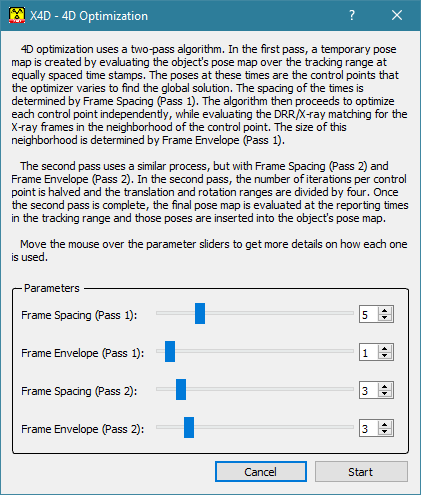Table of Contents
4D Optimization
4D optimization tracks one or more objects by solving all frames in the tracking range at the same time by using a simulated annealing optimization process over two passes.
Simulated Annealing Process
First Pass
In the first pass, a temporary pose map is created by evaluating the object’s pose map over the tracking range at equal time stamps. The object poses at these times are the control points that the optimizer varies to find the global solution. The spacing between the time stamps is determined by the Frame Spacing (Pass 1) parameter. For example, if the parameter is set to 4 and there are 20 reporting times in the tracking range, there will be
20 / 4 + 1 = 6
poses in the pose map– a pose at each end of the range and 4 poses equally spaced between them.
The algorithm then proceeds to optimize each control point independently of the others, while evaluating the DRR/X-ray matching for the X-ray frames in the neighborhood of the control point. The size of this neighborhood is determined by the Frame Envelope (Pass 1) parameter. For example, if the parameter is set to 2, each time the optimizer changes the pose at one of the time stamps, it will evaluate the DRR/X-ray matching at the closest X-ray frame to that time (in each view), and in the 2 frames on either side of that closest frame. A value means to evaluate only the closest X-ray frame.
Second Pass
In the second pass, a temporary pose map is created by evaluating the optimized pose map from the first pass at equal time stamps. This process is the same as described above, but uses the Frame Spacing (Pass 2) parameter to determine the spacing. The algorithm then optimizes each control point independently, evaluating a neighborhood of frames determined by the Frame Envelope (Pass 2) parameter. For this second pass, the number of simulated annealing iterations per control point is halved, the translation and rotation ranges are divided by four, and the initial temperature is divided by four. Once the second pass is complete, its final pose map is evaluated at the reporting times in the tracking range and those poses are inserted into the object’s pose map.
Dialog
The 4D Optimization dialog allows users to specify the frame spacing and frame envelope parameters for both passes.
See Also
See also how X4D matches X-ray and DRR images.

